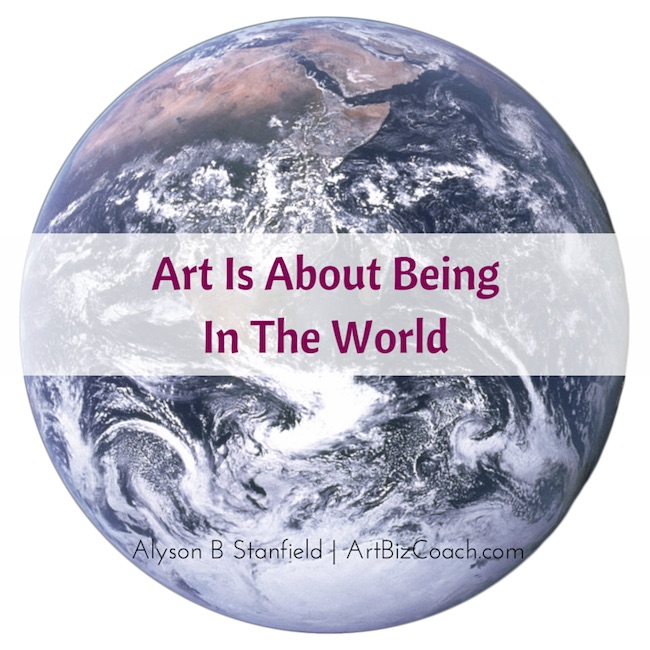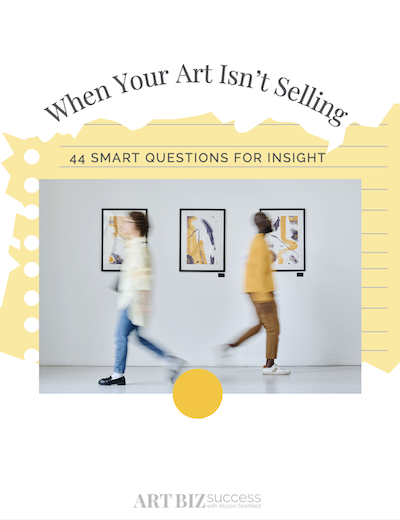[Art] isn’t about being in the studio, it’s about being in the world. – Robert Irwin
I count myself lucky that I ended up at an art talk with Robert Irwin last April.
Irwin didn’t just get off the art school bus. He’s been in the ‘hood for a while now. He’s 86 and was the first artist to receive the John D. and Catherine T. MacArthur “Genius” Award in 1984.
He’s well known for his garden designs, though he says he never gardened or even planted a plant before tackling them.
He didn’t know how the gardens were going to happen. He just knew it was something he wanted to do, so he educated himself through a lot of research.
Irwin is also an educator, though he doesn’t believe that you can teach art. Instead, the art educator’s role should be to encourage and to develop a student’s sensitivity. This, he says, is the crux of being an artist.
You Gotta Get Out and Be
That brings us back to the quote at the beginning of this article.
Art isn’t about being in the studio. It’s about being in the world. [Tweet this]
“Being in the world.” What does it mean?
As a student of art history, I think it means that art is (or should be) informed by life experiences.
Since 2002, I have simultaneously encouraged you to get out of the studio and stay in. Confusing, I know.
You have to have a studio practice in order to make the art that you want to share with the world. You have to get back out of the studio and your comfort zone to put the work in front of more eyeballs.
And, you have to get out of the studio to be inspired by the energy of life.
It’s not just about getting out, though. It’s about being present when you’re out.
Being in the world is a sensory encounter with people, conversations, objects, urban streets, rural roads, or an unexpected garden. It develops your sensitivity, the thing Irwin says artists need to hone most.
Artists are always searching. You’re absorbing what the world has to offer, processing it, and then making us look anew at it.
We count on you to do this for us. We want to experience the world through your creations.
It is said that an artist makes something out of nothing, but you have to go out and find the nothing and then figure out what to do with it. You learn about its properties or its history. In some cases, you research its meaning.
Very few artists find such inspiration alone in their studios.
This is why I love the story of Golden (Colorado) High School art teacher Tim Miller. He has taken his students to interact with the homeless, the elderly at an assisted living center, kids on dialysis in a children’s hospital, and elders at an Indian center.
Tim says, “It’s more important to get them out of their environment, out of their comfort zone,” he said. “I want their artwork to be affected by them being down there and talking one-on-one with their subjects.”
Is Your World Too Small?
Even though you might be getting out and being present in the world, there are five surefire signs that your world is too insulated – that you could improve your art by expanding your inspiration pool.
1. You continue to make the same kind of art, with the same tools, that was taught to you by your teacher.
Your biggest compliment is when someone says that it looks like your teacher’s. (Big red flag here – for you and your teacher!)
2. You enter the same shows year after year and have yet to see good results from participating.
3. You hang out only with artists who use the same medium as you.
4. The last time you visited an art museum was in 2010.
If you really want to be inspired, visit museums on a regular basis. There’s a reason art has made it past the gatekeepers and is installed in museum galleries. It’s quality stuff.
5. The last time you attended an artist lecture was … never!
I find something to think about or write about with every artist lecture I attend. Heck, I wouldn’t have written this newsletter if I had stayed home that night in April and missed Irwin’s lecture.
Don’t live near a metro area with regular artist lectures? Watch the free videos at art:21.
Inspiration is all around you. It’s time to be in the world.




5 thoughts on “Art Is About Being In The World”
Thanks, Alyson, for this advice. According to your list of symptoms, I don’t get out enough.
I would love to attend your webinars of yesterday, today and tomorrow but I have a house full of summer guests. Could you please put me on the list to receive the recording?
Thanks, Gail
Totally agree. Part of developing our unique creative voice is fusing our non-art experiences into our work. Am writing a blogpost on this subject and will link to yours Alyson 🙂
Thanks for the Art-21 link. Excellent resource!
Well, this rang lots of bells for me.
When I decided to leave my academic department, I was kinda fed up with many things.
But one of my last acts of rebellion was to structure my advanced drawing class around a service-learning model. ‘Never been done before in a studio course- this was the late ’90’s.
They worked with Alzheimers patients, kids in Big Brother art programs…. and kept reflection journals about their experiences. This was in addition to class time working on their own series of drawings.
Also, all the years I taught, like Tim Miller, I had all my students go out to various and sundry places to draw and interact with their environment and other people. . . gas stations, laundromats, greenhouses, grocery stores, horse stables, ice rinks, cadaver labs, day care centers, inside power plants…… every new situation compels you to consider, “what do I think about this?”
I was sometimes derided for being too ‘nuturing’, but I knew that helping students find their own voices, (or becoming sensitive to their surroundings as Irwin puts it), well as teaching them solid technique is the whole package. I have no regrets.
You have hit the nail on the head when you say that it is a big red flag when you consider it the greatest compliment to be compared to your teacher, especially if you are making the same type of art with the same tools. It is our separate interpretations that make for a strong piece of art. If we just work in one way and only stick to what we were taught the work can lack something vital. Vibrant art is infused with character and variation. It makes you feel something and you need to form opinions for that to happen. Strong opinions are rooted in our life experiences. we become a reflection of our decisions and feelings. I think this is important information for any artist looking to make a career of their work. Thank you for the insight!
Thanks for this post Alyson, I’ve shared it on my blog today hoping to spread the inspiration for getting out of the studio a little more!
https://www.jenniward.com/being-in-the-world/